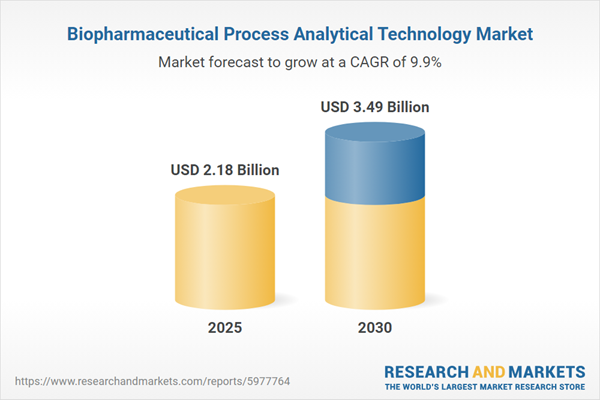Speak directly to the analyst to clarify any post sales queries you may have.
Biopharmaceutical process analytical technology is evolving rapidly to address growing complexities in drug development, manufacturing, and regulatory compliance. Senior decision-makers must understand this dynamic market to guide investments that support innovation, resilience, and long-term growth.
Market Snapshot: Biopharmaceutical Process Analytical Technology Market Size and Growth
The Biopharmaceutical Process Analytical Technology Market grew from USD 1.98 billion in 2024 to USD 2.18 billion in 2025, expanding at a CAGR of 9.85% and projected to reach USD 3.49 billion by 2030. This robust trajectory positions process analytical technology (PAT) as a core enabler for efficiency, regulatory alignment, and competitive positioning in the biopharmaceutical sector.
Scope & Segmentation
This report provides comprehensive coverage of the biopharmaceutical process analytical technology market, analyzing critical segmentation factors, geographic trends, key technologies, and strategic provider landscapes.
- Product Types: Analyzers, sensors & probes (dissolved oxygen sensors, pH sensors, pressure sensors, temperature sensors), software & services.
- Technology: Capillary electrophoresis; chromatography (gas chromatography, liquid chromatography); particle analysis; spectroscopy (mass spectroscopy, near infrared [NIR] spectroscopy, nuclear magnetic resonance [NMR] spectroscopy, Raman spectroscopy, UV-visible spectroscopy).
- Measurement Types: At-line measurement, in-line measurement, off-line measurement, on-line measurement.
- Process Stages: Downstream processing, formulation & fill-finish, upstream processing.
- End Users: Academic research institutes, contract manufacturing organizations, pharmaceutical & biopharmaceutical companies.
- Applications: Process monitoring, quality control, stability testing, troubleshooting, root cause analysis.
- Scale: Laboratory bench, micro scale systems, pilot bioreactors, commercial-scale operations (single-use or stainless-steel equipment).
- Regions:
- Americas: United States, Canada, Mexico, Brazil, Argentina, Chile, Colombia, Peru
- Europe, Middle East & Africa: United Kingdom, Germany, France, Russia, Italy, Spain, Netherlands, Sweden, Poland, Switzerland, United Arab Emirates, Saudi Arabia, Qatar, Turkey, Israel, South Africa, Nigeria, Egypt, Kenya
- Asia-Pacific: China, India, Japan, Australia, South Korea, Indonesia, Thailand, Malaysia, Singapore, Taiwan
- Companies Analyzed: ABB Ltd., Agilent Technologies, Anton Paar GmbH, Bio-Rad Laboratories, Bruker Corporation, Carl Zeiss AG, Danaher Corporation, Emerson Electric, F. Hoffmann-La Roche AG, GL Sciences Inc., Hamilton Company, Horiba, Jasco, Merck KGaA, Mettler-Toledo, PerkinElmer, Sartorius AG, SCION Instruments, Shimadzu, Siemens, Spectris PLC, SRI Instruments Europe GmbH, Teledyne Technologies, Thermo Fisher Scientific, Waters Corporation.
Key Takeaways for Senior Decision-Makers
- Adoption of real-time analytics and hybrid platform integration strengthens quality control while reducing production cycle times across bioprocessing environments.
- Technological advances such as miniaturized biosensors, advanced spectroscopic probes, and digital twins are reshaping process monitoring, anomaly detection, and maintenance strategies.
- Regulatory trends now favor risk-based and continuous verification approaches, rewarding early investments in adaptive, knowledge-driven quality frameworks.
- Cross-functional collaboration between process engineers, analytical scientists, and data experts enhances iterative improvement, process understanding, and technology transfer outcomes.
- Automation, robotics, and cloud-based infrastructure are enabling operational efficiency, remote monitoring, and collaborative troubleshooting at global manufacturing sites.
- Strategic partnerships among instrument manufacturers, software vendors, and contract service providers are accelerating integrated PAT adoption and seamless scale-up.
Tariff Impact: Navigating the Changing U.S. Regulatory Environment
The 2025 U.S. tariff regime on imported PAT-related instrumentation and consumables has increased cost pressures, prompting organizations to reevaluate procurement and sourcing strategies. Industry responses include diversifying vendor relationships, shifting to domestic manufacturing, and developing regional service hubs to mitigate supply chain risks and maintain operational continuity.
Methodology & Data Sources
Research utilizes a robust mixed-methods design, incorporating structured interviews with industry executives, review of regulatory and scientific literature, and advanced statistical analysis. Triangulation and advisory panel reviews reinforce the accuracy and relevance of all insights, ensuring alignment with actual industry experience.
The Strategic Value of This Report
- Enables evidence-based investment, technology selection, and process improvement initiatives with actionable, segmented market insights specific to biopharmaceutical process analytical technology.
- Supports effective risk management, supply chain planning, and partnership strategies amid regulatory changes and global market complexity.
Conclusion
Biopharmaceutical process analytical technology offers senior leaders actionable pathways to strengthen process efficiency, regulatory compliance, and innovation. Strategic adoption will be essential for navigating emerging complexity and maintaining competitive advantage.
Additional Product Information:
- Purchase of this report includes 1 year online access with quarterly updates.
- This report can be updated on request. Please contact our Customer Experience team using the Ask a Question widget on our website.
Table of Contents
3. Executive Summary
4. Market Overview
7. Cumulative Impact of Artificial Intelligence 2025
Companies Mentioned
The companies profiled in this Biopharmaceutical Process Analytical Technology market report include:- ABB Ltd.
- Agilent Technologies, Inc.
- Anton Paar GmbH
- Bio-Rad Laboratories, Inc
- Bruker Corporation
- Carl Zeiss AG
- Danaher Corporation
- Emerson Electric Co.
- F. Hoffmann-La Roche AG
- GL Sciences Inc.
- Hamilton Company
- Horiba, Ltd.
- Jasco, Inc.
- Merck KGaA
- Mettler-Toledo International Inc.
- PerkinElmer, Inc.
- Sartorius AG
- SCION Instruments NL BV
- Shimadzu Corporation
- Siemens AG
- Spectris PLC
- SRI Instruments Europe GmbH
- Teledyne Technologies Incorporated
- Thermo Fisher Scientific, Inc.
- Waters Corporation
Table Information
| Report Attribute | Details |
|---|---|
| No. of Pages | 193 |
| Published | November 2025 |
| Forecast Period | 2025 - 2030 |
| Estimated Market Value ( USD | $ 2.18 Billion |
| Forecasted Market Value ( USD | $ 3.49 Billion |
| Compound Annual Growth Rate | 9.8% |
| Regions Covered | Global |
| No. of Companies Mentioned | 25 |









